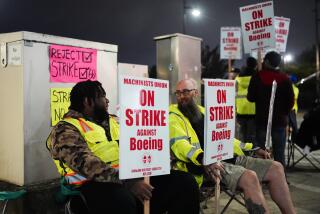Boeing Gets Its Third-Largest Order : Airliners: Korean Air has requested 23 new 747-400s, in a deal potentially worth $4.8 billion. The order could help pare the U.S. trade deficit.
- Share via
NEW YORK — Korean Air, the privately held South Korean carrier, Monday ordered 23 of Boeing Co.’s new 747-400 airliners in an order likely to be worth $4.8 billion.
The order, third-largest in the Seattle-based manufacturer’s history, will greatly help decrease the trade imbalance between South Korea and the United States. It was announced during a visit to Washington, D.C., by a South Korean trade mission.
The airline had previously ordered nine of the big jetliners. The first was delivered a year ago, and the carrier now has three in operation.
Boeing Chairman Frank Shrontz said at a Washington news conference that delivery of the newly ordered planes will begin in 1994 and continue through the 1990s. The 747-400, the newest model of the 20-year-old 747 type, has a passenger capacity of 392 passengers in three classes and a range of 8,000 miles.
Boeing, as is its policy, declined to divulge the price that Korean Air will pay for each plane. However, a recent order for 20 747-400s and options for 34 more by Japan Airlines was calculated at about $130 million per plane.
Boeing said the South Korean order includes spare parts and crew training and that the total was calculated in terms of inflation-adjusted dollars to reflect what the price of each plane is expected to be when it is delivered.
However, Paul Turk, an analyst with Avmark, an Arlington, Va., aviation consulting group that closely follows price trends, said spare parts and training generally account for 15% of airliner sales prices. That indicates that after deducting 15%, or $72 million, from the total price, the planes would cost about $177 million each, Turk said.
“That is still very high,” he said. “But they may be . . . inflating the values in order to reduce the trade imbalance.”
Asked to comment on that assertion, Ho Suk Byun, a Korean Air executive in New York, said the “prices might be high to lessen the trade deficit, (but) I don’t know about that.”
“I really don’t know about that,” said Valerie Kasuda-Smick, a Boeing spokeswoman. “Our price is based on spare parts, training and price expected at delivery time.”
For Boeing, the order continues a run of great success. Each year since 1985, the plane maker’s sales have set records. It has a backlog of orders that will take it almost until the end of the century to fill. The orders are for 1,760 planes worth about $91 billion.
This year so far, Boeing has received orders for $19.29 billion worth of planes, but it may be difficult for the company to match its 1989 record. By this time last year, orders worth $32.46 billion had been received, including $19.4 billion in April alone; for all of last year, Boeing wrote orders for $46.75 billion.
The two largest orders in company history came last April--from GPA Ltd., an Irish leasing company that ordered $9.4 billon in jets, and from United Airlines, which ordered $7.1 billion worth.
Monday’s South Korean order brings the number of total orders Boeing has received for the 747-400 model to 307, of which 71 have been delivered.
The Korean transaction includes 12 firm orders and 11 “reconfirmations.” A reconfirmation gives the customer the right to cancel the order at a future date but is considered more binding than a different kind of commitment called an “option.” Boeing said it considers all the Korean Air orders to be “firm.”
“I don’t know of another corporation worldwide that has anything close to the backlog Boeing has,” said Paul Nisbet, an analyst for the Prudential Bache investment firm who covers Boeing. Airliners are in such demand and in such short supply, he said, that “any planes coming off the assembly line which the intended customer does not want would sell at a 20% premium today.”
In 1969, the Korean government appointed a private group to take over its fiscally ailing national air carrier. Given the mission to energize Korean civil aviation, Korean Air has rapidly blossomed from a primarily domestic carrier with an occasional flight to Japan into one of the world’s leading airlines, linking all seven continents and ranking eighth in passenger volume worldwide. Korean Air now operates 65 aircraft, provides service to 40 cities throughout the world and plans to add Rome and Sydney to the destination roster later this year.
The airline opened a Los Angeles sales office 20 years ago. It has three daily flights from Los Angeles to Seoul.
Times researcher Lisa Phillips in New York contributed to this article.
More to Read
Inside the business of entertainment
The Wide Shot brings you news, analysis and insights on everything from streaming wars to production — and what it all means for the future.
You may occasionally receive promotional content from the Los Angeles Times.










